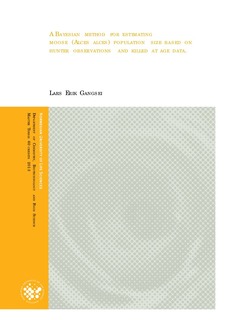| dc.description.abstract | Lots of wild species, fish and mammals, are heavy harvested through fishing and hunting.
Reliable population size estimates are valuable management tools for these species. In
cases where killed at age data are available, models outlined under the framework known
as ”cohort analysis” or ”virtual population analysis (VPA)” are used extensively. In fish
stock management several models using Bayesian techniques have been developed through
the last two decades.
In this study a model using a Bayesian approach for estimating moose population size
is examined. The model combines principles from discrete time series analysis, where basic
cohort analysis based on killed at age data constitutes the bulk, and analysis in continuous
time for each hunting season based on data from hunter observations. The analysis in
continuous time aims to find age- and year-specific expressions for the hunting mortality
rate. In the discrete time series analysis, the hunting yield is viewed as a binomially
distributed variable, with pre-harvest population size as ”number of trials” and mortality
rate derived from the analysis in continuous time as ”probability parameter”. All basic
principles are known from previous surveys, but the way they are assembled is, to the
authors knowledge, innovative.
The model performed very well when tested against simulated populations with known
parameter values. For real data tests are conducted through cross-validation based on
spatial subsets and by comparing results from temporal subsets. Generally the model
performed well in these test. However, an issue is revealed by comparing results from
different temporal subsets, since the hunters ability to spot moose seems to develop over
time (years) and/or depend on moose density. This issue should not terminate the practical
implementation of the model. If a satisfying solution to the issue is achieved, it might have
a possible positive impact on other methods for estimating abundance of wild species based
on effort, a very prevalent class of models.
The real data used for testing the model, and to demonstrate some practical interpretations,
are from the municipality of Ringerike in southern Norway. Killed at age data
are available from 1988 till 2012 in combination with hunter observations. The estimates show a moose population size rapidly increasing in the period from 1988 till its peak in
1993 at a posterior mean population size of approximately 3900 individuals. Thereafter,
in line with large hunting yields, reduced reproductivity rate and increased rate of natural
mortality, the population size declined rapidly till an estimated pre-harvest population size
of approximately 1700 individuals in year 2000. Thereafter the total population size has
been estimated as quite stable, but with a declining trend over the last couple of years.
Usually the natural (non harvest) mortality rate is assumed fixed and known when
cohort analysis methods are used for estimating abundance of wild species. The model
presented in this study is capable of producing reliable, and to some extent practical
beneficial, posterior distributions for the natural mortality rate based on an informative
prior distribution and an adequate amount of data. These posterior distributions for
natural mortality rates indicate surprisingly high rates for the years around 1993. | no_NO |
